#phlegon
Text
Geological and Historical Evidence for Jesus’ Crucifixion Account

At Jesus’ crucifixion, Matthew (27:45-54) reported “From noon until three in the afternoon darkness came over all the land. About three in the afternoon Jesus cried out in a loud voice ‘My God, my God, why have you forsaken me?’ (cf., Psalm 22)…And when Jesus had cried out again in a loud voice, he gave up his spirit. At that moment, the curtain of the temple was torn in two from top to bottom. The earth shook, the rocks split and the tombs broke open. The bodies of many holy people who had died were raised to life. They came out of the tombs after Jesus’ resurrection and went into the holy city and appeared to many people. When the centurion and those with him who were guarding Jesus saw the earthquake and all that happened, they were terrified, and exclaimed, ‘Surely he was the son of God!’”
Matthew’s passage includes two events that can be historically and geologically confirmed: (1) Darkness covered the land for three hours (c.f., Matthew 27:45; Mark 15:33; Luke 23:44-45) and (2) An earthquake occurred.
“At that same moment about noontide, the day was withdrawn; and they, who knew not that this was foretold concerning Christ, thought it was an eclipse. But this you have in your archives; you can read it there. Yet nailed upon the cross, Christ exhibited many notable signs, by which his death was distinguished from all others. At his own free-will, he with a word dismissed from him his spirit, anticipating the executioners’ work. In the same hour, too, the light of day was withdrawn, when the sun at the very time was in his meridian blaze. Those who were not aware that this had been predicted about Christ, no doubt thought it was an eclipse.”
- Tertullian (197 AD), Jewish Consul
“In the 4th year of the 202nd Olympiad, there was a great eclipse of the sun, greater than had ever been known before, for at the 6th hour the day was changed into night and the stars were seen in the heavens. An earthquake occurred in Bythinia and overthrew a great part of the city of Nicaea.”
- Phlegon (2nd century AD) Greek historian, “Olympiads”
“With regard to the eclipse in the time of Tiberius Caesar, in whose reign Jesus appears to have been crucified, and the great earthquakes which then took place, Phlegon too I think has written in the 13th or 14th book of his Chronicles…Celsus imagines also that both the earthquake and darkness were an invention, but regarding these, we have in the preceding pages made our defense, according to our ability, adducing the testimony of Phlegon, who relates that these events took place at the time when our Savior suffered.”
- Origen (184 – 253 AD), Greek scholar and early Christian father who confirmed Phlegon’s writings
“Jesus Christ underwent his passion in the 18th year of Tiberius [33 AD]. Also at that time in another Greek compendium we find an event recorded in these words: ‘the sun was eclipsed, Bithynia was struck by an earthquake, and in the city of Nicaea many buildings fell.”
- Eusebius (315 AD), Historian of the Emperor Constantine.
What Caused the Three-hour Period of Darkness?
Before determining that the three-hour period of darkness is due to supernatural causes, we must rule out the natural possibilities. We have experienced natural events that have caused darkness during the daylight hours. These include when volcanoes erupt and emit dark clouds and when storms occur and cover the sky with clouds. Yet no Biblical or secular sources indicate any support for a volcanic explosion or storms, so we can rule out those two natural events.
What about an eclipse? The positioning of the sun and moon is required to answer this question. We have much support for the dating of Jesus’ crucifixion on Friday the 14th of Nissan in the year 33 (April 3, 33). This date was further predicted in the book of Daniel (9). Passovers only occurred during a full moon, so an eclipse would not have been possible due to the moon’s location on the far side of the earth away from the sun. Even if the positioning were conducive to an eclipse, eclipses only darken the earth for short moments, not for three hours, so we have another reason to rule out that natural option.
Is the Best Explanation to Explain this Event a Supernatural Explanation?
I will let readers answer that question for themselves.
Geological Support for the Earthquake

Scholars have reported that devastating earthquakes occurred in Jerusalem during Christ’s death (Mallet, 1853; Rigg, 1941). This occurred in a region that includes the Dead Sea fault, which is a plate boundary that separates the Arabian plate and the Sinai sub-plate (Garfunkel, 1981). This fault has been active since the Miocene (Kagan, Stein, Agnon, & Neuman, 2011) and the fault is still active today (De Liso & Fidani, 2014). The fault extends from the Red Sea in the south to the Taurus Mountains in the north.

Kagan and colleagues (2011) analyzed seismites in the Holocene Dead Sea basin by constructing two age-depth chronological models based on atmospheric radiocarbon ages of short-lived organic debris with a Bayesian model. Seismites are sedimentary beds and structures, which are deformed by seismic shaking. The scholars analyzed seismites in different areas of the basin, finding that several synchronous seismites appeared in all sections during particular years, including 33 AD (+/- 2 sigma; 95% confidence interval). Other years in which earthquakes occurred as evidenced by seismites are (AD unless otherwise noted): 1927, 1293, 1202/1212, 749, 551, 419, 33, 31 BC, and mid-century B.C.
After analyzing laminated sedimentary cores recovered at the shores of the Dead Sea, Migowski, Agnon, Bookman, Negendank, and Stein (2004) also confirmed an earthquake in 33 AD with a magnitude of 5.5. They documented earthquakes around 33 AD in 31 BC and 76 AD. The scholars analyzed seismites using radiocarbon dating.
Ben-Menahem (2014) conducted a literature review of empirical studies over 4,000 years of seismicity along the Dead Sea Rift. The scholar referenced the aforementioned studies along with one by Enzel, Kadan, and Eyal (2000) before concluding that earthquakes occurred in Masada in 31 BC, Jerusalem in 33 AD, and near Nablus in 64 AD.
In summary, the literature on seismicity along the Dead Sea basin supports the assertion that an earthquake occurred either in or very close to the year 33 AD.
We can pinpoint the date even closer – to April 3, 33. A United States government federal agency, the National Oceanic and Atmospheric Administration, has documented the major earthquakes throughout history. According to their website (NOAA.gov), in 33 AD, an earthquake occurred at the crucifixion of Jesus Christ in Bithynia and Palestine and Palestine, Jerusalem.
Conclusion
In summary, we have extensive extra-biblical support for the accounts of darkness and the earthquake during Jesus’ crucifixion. Taken together, these events support the historicity of the account of Jesus’ crucifixion.
source: abbreviated from https://christian-apologist.com/2019/01/05/geological-and-historical-evidence-for-jesus-crucifixion-account/
#church history#catholic#Christian#crucifixion#good friday#geology#origen#eusebius#tertullian#phlegon
268 notes
·
View notes
Text
@just-late-roman-republic-things seems to be plowing through Suetonius Augustus and I am here for it!
Your mention of the dinosaur bones that Augustus used as home decoration reminds me of a story about Tiberius! (I swear, everything recently has been reminding me about Tiberius!)
By the way, finding the ancient source for this story was shit! I remembered reading this like a year ago, and I had forgotten which ancient source this was from. Using my critical thinking skills ("hmmm tiberius hmmmm dinosaur"), I assumed that this story came from Pliny's Natural History.
It did not.
I was searching through the Natural History for so long that I was starting to wonder if I had made the story up!
After searching through the Natural History for ages, I finally used more critical thinking skill and was like "Hmmm. Maybe if I google this, I could find an article about the event and maybe possibly it would cite a specific part of the Natural History!"
I googled it, found an article about the event, and it cited Phlegon's Book of Marvels.
Whoopsie! I was looking through the wrong book this whole time! In my defense, Pliny and Phlegon actually are pretty similar names if you squint sooo...
(it was however worth it to look through the Natural History because I found the funniest story about Tiberius ever but that's a story for another day)
Now that I have the ancient source of this story, I can finally tell it!
Basically, there was an earthquake which opened up all sorts of cracks on the ground. And in those cracks, there were dinosaur bones!
The people were pretty spooked so they took a tooth and sent it to Rome. And this was a massive tooth.
The tooth was showed to Tiberius and he was asked if he wanted the rest of the bones. He was like "Well, I'm really curious about this thing, and I'm aching to get an idea of what size it was, but it feels like graverobbing to take the rest of the bones."
So Tiberius got some dude called Pulcher who was skilled in geometry. Tiberius asked him to make a face in proportion to the tooth. The dude estimated the size of the creature using its tooth as a reference and then showed Tiberius a construction of it he had made. Tiberius said that looking at the construction was good enough and sent the tooth back where it came from.
Tiberius and (especially) Pulcher, the world's first paleontologists!
I love this story. It's wild. Though I do wonder what happened to the construction. Did Tiberius keep it?
If Tiberius randomly showed up at my door one day, I'd bring him to Drumheller to go to the Royal Tyrrell Museum. Alberta is one of the most boring places in the world but we do have a banging dinosaur museum!
On the hours-long drive there, I will most certainly give him like a billion questions, though. "How was Caligula like? How was Augustus like? How were you like? How was Livia like? How was Sejanus like? Actually, scratch this. Name every single person you know and tell me how they were like and how they looked like. What did you do in Capri? Explain your entire life from beginning to end, giving extra attention to the personal parts! I don't want to hear about wars I want to hear about what people were like! Could you read Suetonius to me and point out parts where he's wrong? Could we watch Domina together and you can tell me if you like your characterization or not?"
For everyone's sake, it's good that dead Roman emperors usually don't randomly show up sometimes (not counting whatever the fuck was happening right after Nero died!)
If you want to read the Tiberius Tooth sTory (haha Triple T) for yourself, you can here. Look for §13.
#ancient rome#roman history#ancient history#history#tiberius#emperor tiberius#dinosaur#dinosaurs#phlegon#phlegon book of marvels#pliny the elder#paleontology
38 notes
·
View notes
Text
Darkness, Earthquakes, And The Dead Walking!
Darkness, Earthquakes, And The Dead Walking!
Tuesday’s Column: Dale Mail
Dale Pollard
In Matthew 27 we find the start of what appears to be a mixture of supernatural and natural phenomena.
Clearly, Matthew, Mark, and Luke (the inspired authors of the synoptic gospels) make an airtight case for the diety of Jesus. Additionally, three extra biblical historians validate their accounts as well: Thallus, Africanus (the name of Janelle’s and…

View On WordPress
#Africanus#crucifixion#dead#Elijah#graves#Greek#Matthew#Moses#Old Testament#Phlegon#raised#saints#synoptics#Thallus#Tiberius Caesar#tombs#Transfiguration
0 notes
Photo

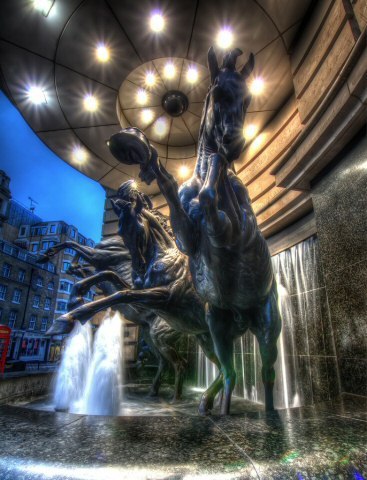
The Four Bronze Horses of Helios, by Rudy Weller
Piccadilly Circus, London, UK
1 note
·
View note
Text
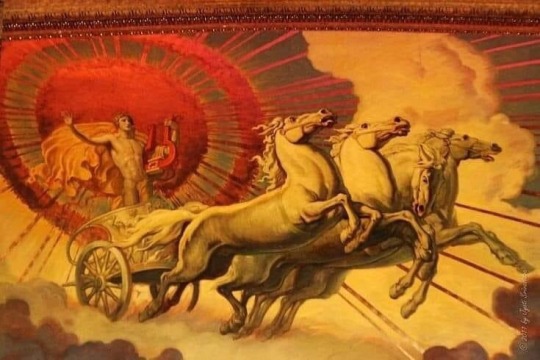
What are Apollo's 4 horses called?
The four horses were named AETHON, PYROIS, PHLEGON, EOUS 🌞🐎🐎🐎🐎🌞
222 notes
·
View notes
Text
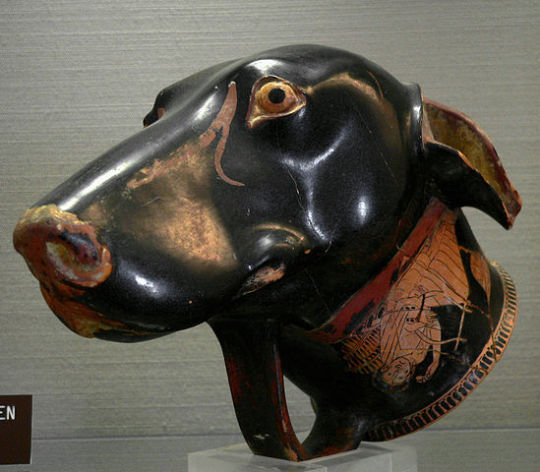
Some Pet Dog Names from Ancient Greece
When the hound has caught the hare, or been otherwise victorious in the course, you should […] pat him with your hand and praise him, kissing his head, and stroking his ears, and speaking to him by name […] for, like men of generous spirit, they love to be praised; and the dog, if not quite tired out [from the hunt] will come up with joy to caress you. (Arrian, On Coursing, XVIII Pg 116 trans. William Dansey)
As many dogs were hunting hounds or guard dogs in Ancient Greece, it followed that the naming convention was dependant on psychology; to name the dog something strong or skilful was to boast of the animals’ superiority to others of its breed, just as it reflected on the owner. There are some well known dogs in Ancient Greek history that many are aware of, namely Cerberus, Odysseus’ faithful dog Argos, and Alexander the Great named a city after his dog Peritas. We are lucky to have two lists of excellent dog names from authors Xenophon and Ovid.
From Xenophon (~ 430 - 355 BC), in his treaties on Hunting, we have the below list:
Give the hounds short names, so as to be able to call to them easily. The following are the right sort: Psyche, Thymus, Porpax, Styrax, Lonchê (Lance), Lochus, Phrura, Phylax (Sentinel/Guardian), Taxis, Xiphon, Phonax, Phlegon, Alcê (Stout), Teuchon, Hyleus, Medas (Crafty), Porthon, Sperchon (Bustler/Hasty), Orgê, Bremon, Hybris, Thallon (Vigorous), Rhomê, Antheus (Blossom), Hebe, Getheus, Chara (Jolly/Ecstasy), Leusson, Augo (Bright), Polys, Bia, Stichon, Spudê, Bryas, Oenas (Blueskin), Sterrus, Craugê, Caenon, Tyrbas, Sthenon, Aether, Actis, Aechmê, Noes (Counsellor), Gnomê, Stibon, Hormê (Impetus). (Xenophon Kynegetikos On Hunting 7.5)
A kind person on Reddit suggested these names could also translate as:
Psyche = Psyche / Spirit
Thymus = Pluck
Porpax = Buckler
Styrax = Spigot
Lonche = Lance
Lochus = Lurcher
Phrura = Watch
Phylax = Keeper
Taxis = Brigade
Xiphon = Fencer
Phonax = Butcher
Phlegon = Blazer
Alce = Prowess
Teuchon = Craftsman
Hyleus = Foster
Medas = Counsellor
Porthon = Spoiler
Sperchon = Hurry
Orge = Fury
Bremon = Growler
Hybris = Riot / Insolence
Thallon = Bloomer
Rhome = Rome / Mighty
Antheus = Blossom
Hebe = Hebe / Youth (Young’n)
Getheus = Hilary / Happy
Chara = Jollity
Leusson = Glazer
Augo = Eyesbright
Polys = Much
Bia = Force
Stichon = Trooper
Spude = Bustle
Bryas = Bubbler
Oenas = Rockdove
Sterrus = Stubborn
Crauge = Yelp
Caenon = Killer
Tyrbas = Strongboy / Riot
Sthenon = Sky
Aether = Sunbeam
Actis = Bodkin
Aechme = Wistful
Noes = Gnome
And from Ovid (~ 43 BC - 17 AD), in his Metamorphosis, of the dogs that attacked their master Actaeon, we have:
First ‘Black-foot’, Melampus, and keen-scented Ichnobates, ‘Tracker’, signal him with baying, Ichnobates out of Crete, Melampus, Sparta. Then others rush at him swift as the wind, ‘Greedy’, Pamphagus, Dorceus, ‘Gazelle’, Oribasos, ‘Mountaineer’, all out of Arcadia: powerful ‘Deerslayer’, Nebrophonos, savage Theron, ‘Whirlwind’, and Laelape, ‘Hunter’. Then swift-footed Pterelas, ‘Wings’, and trail-scenting Agre, ‘Chaser’, fierce Hylaeus, ‘Woody’, lately gored by a boar, the wolf-born Nape, ‘Valley’, Poemenis, the trusty ‘Shepherd’, and Harpyia, ‘Snatcher’, with her two pups. There is thin-flanked Sicyonian Ladon, ‘Catcher’, Dromas, ‘Runner’, ‘Grinder’, Canache, Sticte ‘Spot’, Tigris ‘Tigress’, Alce, ‘Strong’, and white-haired Leucon, ‘Whitey’, and black-haired Asbolus, ‘Soot’. Lacon, ‘Spartan’, follows them, a dog well known for his strength, and strong-running Aëllo, ‘Storm’. Then Thoos, ‘Swift’, and speedy Lycisce, ‘Wolf’, with her brother Cyprius ‘Cyprian’. Next ‘Grasper’, Harpalos, with a distinguishing mark of white, in the centre of his black forehead, ‘Black’, Melaneus, and Lachne, ‘Shaggy’, with hairy pelt, Labros, ‘Fury’, and Argiodus, ‘White-tooth’, born of a Cretan sire and Spartan dam, keen-voiced Hylactor, ‘Barker’ […] First ‘Black-hair’, Melanchaetes, wounds his back, then ‘Killer’, Theridamas, and Oresitrophos, the ‘Climber’, clings to his shoulder. (Ovid Metamorphoses III 206-233 trans. A S Kline)
Theoi has Brookes More’s translation which offers a few English variations on the names.
A few fun ideas to keep in mind if looking to name a new pet in Ancient Greek style.
For I have myself bred up a hound whose eyes are the greyest of grey; a swift, hard-working, courageous, sound-footed dog[…]. He is most gentle, and kindly-affectioned […] as soon as he catches sight of me, showing symptoms of joy, and again trotting on before me. […] He is the constant companion of whichever may be sick; and if he has not seen either of us for only a short time, he jumps up repeatedly by way of salutation, and barks with joy as a greeting. (Arrian, On Coursing, V Pg 78-80 trans. William Dansey)
🐶 Sources
Xenophon Kynegetikos
Arrian On Coursing
Ovid Metamorphoses III
Dog shaped Rhyton by the Brygos Painter in Aleria
64 notes
·
View notes
Text

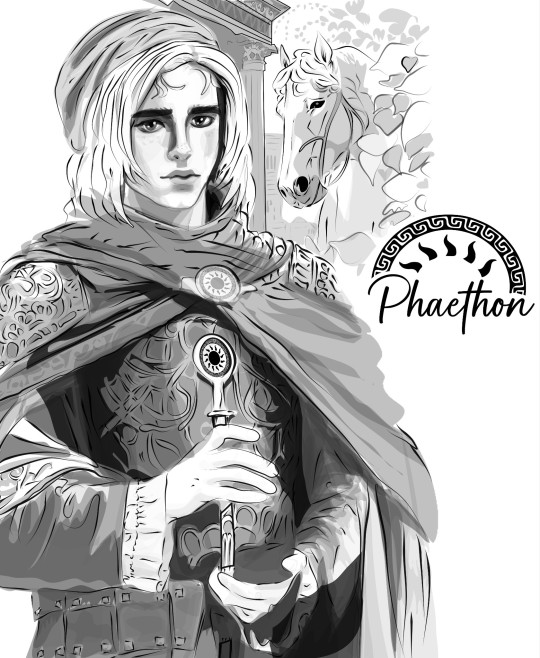
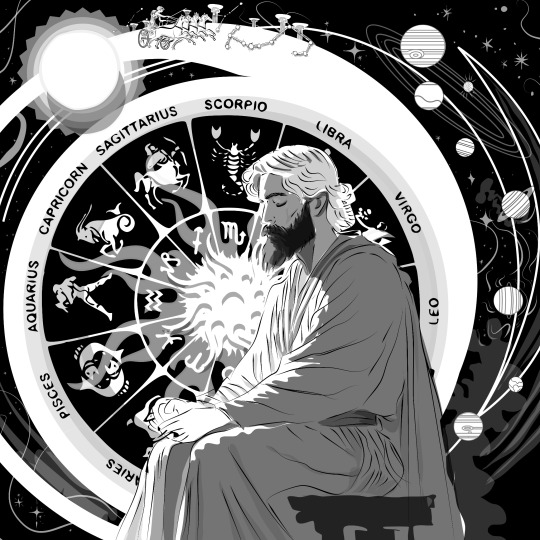
Here's my Sketch of the four horses of Helios and his son Phaethon.


The history of Helios'd horses is really a fun dive. If you look closely, the horses in the illustrations are actually very small. That is because miniature horses were bred for war in 800-500 BCE. Hailing from the island of Skyros, they are only 10 hands tall! (Pictured Below).


According to Ovid, the four immortal horses are Aethon, Eous, Phlegon, and Pyrois. In ancient greek they were 2 female horses in the front, Thunder and Lightning. Two male horses in the rear (Time and flame).
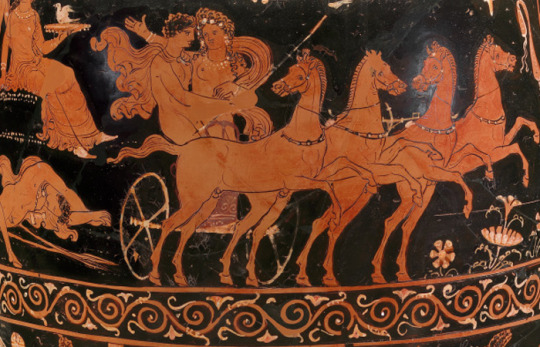
Helios is not the only one in ancient mythos to have horses. His two sisters, Selene (moon) and Eos (Dawn) ride the sky with him and both have four horses each. These make up the THE HIPPOI ATHANATOI, the immortal horses.


Alright, that's my history rant🐍💕
#helios#phaethon#skyros#horse#horse art#greek myth art#ancient greece#greek mythology#ancient history#mythology#mythology and folklore#greek gods#pony#ovid#selene#eos#fire horse#flame horse#helius#heilos#lancel lannister#eugine simon#Aethon#Eous#Phlegon#Pyrios#miniature horse#percy jackson#greek history#horse facts
10 notes
·
View notes
Text
Barking Harker Cast Snapshot 11: Detours

Let me add a word or two about that quaint Baron Vordenburg, to whose curious lore we were indebted for the discovery of the Countess Mircalla’s grave. He had taken up his abode in Gratz, where, living upon a mere pittance, which was all that remained to him of the once princely estates of his family, in Upper Styria, he devoted himself to the minute and laborious investigation of the marvelously authenticated tradition of Vampirism. He had at his fingers’ ends all the great and little works upon the subject. “Magia Posthuma,” “Phlegon de Mirabilibus,” “Augustinus de cura pro Mortuis,” “Philosophicae et Christianae Cogitationes de Vampiris,” by John Christofer Herenberg; and a thousand others, among which I remember only a few of those which he lent to my father. —Laura, Carmilla
“I have studied, over and over again since they came into my hands, all the papers relating to this monster, and the more I have studied, the greater seems the necessity to utterly stamp him out. All through there are signs of his advance. Not only of his power, but of his knowledge of it. As I learned from the researches of my friend Arminius of Buda-Pesth, he was in life a most wonderful man. Soldier, statesman, and alchemist. Which latter was the highest development of the science knowledge of his time. He had a mighty brain, a learning beyond compare, and a heart that knew no fear and no remorse. He dared even to attend the Scholomance, and there was no branch of knowledge of his time that he did not essay.” —Abraham Van Helsing, Dracula
Behold two men of letters.
Letters written. Letters burned.
Lessons taught. Lessons learned.
Both are far older than they look.
Both have grown adept at telling the right kind of tale to soothe an audience into believing otherwise. Ancestors invented. A lineage of sons all bearing the same name. Never mind, friends, never mind. Who wants to hear a story of old? Of all the men who were not me, but saw and did such bloody works?
Both have a vision.
Though only one of the two has Vision. A useful gift. Knowledge always is, so long as proper action can follow. And the proper action must follow. It has to.
(England is the least of what he’s after. Please. It will all bleed.)
More details about Barking Harker here.
#fuckin LOOKS at you 👁👁#dracula#carmilla#barking harker#bram stoker#sheridan le fanu#my writing#my art#horror
39 notes
·
View notes
Text
Saints&Reading: Wednesday, January 17, 2024
january 4_ januaryry 14
The hymns compare the Feast of the Nativity with the coming Feast. “There shepherds saw the Child and were amazed; here the voice of the Father proclaims the only-begotten Son.”
SYNAXIS OF THE SEVENTY APOSTLES

The Synaxis of the Seventy Apostles was established by the Orthodox Church to indicate the equal honor of each of the Seventy. They were sent two by two by the Lord Jesus Christ to go before Him into the cities He would visit (Luke 10:1).
Besides the celebration of the Synaxis of the Holy Disciples, the Church celebrates the memory of each of them during the course of the year:
Saint James the Brother of the Lord (October 23); Mark the Evangelist (April 25); Luke the Evangelist (October 18); Cleopas (October 30), brother of Saint Joseph the Betrothed, and Simeon his son (April 27); Barnabas (June 11); Joses, or Joseph, named Barsabas or Justus (October 30); Thaddeus (August 21); Ananias (October 1); Protomartyr Stephen the Archdeacon (December 27); Philip the Deacon (October 11); Prochorus the Deacon (July 28); Nicanor the Deacon (July 28 and December 28); Timon the Deacon (July 28 and December 30); Parmenas the Deacon (July 28); Timothy (January 22); Titus (August 25); Philemon (November 22 and February 19); Onesimus (February 15); Epaphras and Archippus (November 22 and February 19); Silas, Silvanus, Crescens or Criscus (July 30); Crispus and Epaenetos (July 30); Andronicus (May 17 and July 30); Stachys, Amplias, Urban, Narcissus, Apelles (October 31); Aristobulus (October 31 and March 16); Herodion or Rodion (April 8 and November 10); Agabus, Rufus, Asyncritus, Phlegon (April 8 ); Hermas (November 5, November 30 and May 31); Patrobas (November 5); Hermes (April 8); Linus, Gaius, Philologus (November 5); Lucius (September 10); Jason (April 28); Sosipater (April 28 and November 10); Olympas or Olympanus (November 10 ); Tertius (October 30 and November 10 ); Erastos (November 30), Quartus (November 10 ); Euodius (September 7); Onesiphorus (September 7 and December 8); Clement (November 25); Sosthenes (December 8); Apollos (March 30 and December 8); Tychicus, Epaphroditus (December 8); Carpus (May 26); Quadratus (September 21); Mark (September 27), called John, Zeno (September 27); Aristarchus (April 15 and September 27); Pudens and Trophimus (April 15); Mark nephew of Barnabas, Artemas (October 30); Aquila (July 14); Fortunatus (June 15) and Achaicus (January 4).
With the Descent of the Holy Spirit the Seventy Apostles preached in various lands. Some accompanied the Twelve Apostles, like the holy Evangelists Mark and Luke, or Saint Paul’s companion Timothy, or Prochorus, the disciple of the holy Evangelist John the Theologian, and others. Many of them were thrown into prison for Christ, and many received the crown of martyrdom.
There are two more Apostles of the Seventy: Saint Cephas, to whom the Lord appeared after the Resurrection (1 Cor. 15:5-6), and Simeon, called Niger (Acts 13:1). They also were glorified by apostolic preaching.
There are discrepancies and errors in some lists of the Seventy Apostles. In a list attributed to Saint Dorotheus of Tyre (June 5) some names are repeated (Rodion, or Herodion, Apollos, Tychicus, Aristarchus), while others are omitted (Timothy, Titus, Epaphras, Archippus, Aquila, Olympas). Saint Demetrius of Rostov consulted the Holy Scripture, the traditions passed down by the Fathers, and the accounts of trustworthy historians when he attempted to correct the mistakes and uncertainties in the list in compiling his collection of Lives of the Saints.
The Church in particular venerates and praises the Seventy Apostles because they taught us to honor the Trinity One in Essence and Undivided.
In the ninth century Saint Joseph the Hymnographer composed the Canon for the Synaxis of the Seventy Apostles of Christ.
Source: Orthodox Church in America_OCA


1 PETER 4:1-11
1 Therefore, since Christ suffered for us in the flesh, arm yourselves also with the same mind, for he who has suffered in the flesh has ceased from sin, 2 that he no longer should live the rest of his time in the flesh for the lusts of men, but for the will of God. 3 For we have spent enough of our past lifetime in doing the will of the Gentiles-when we walked in lewdness, lusts, drunkenness, revelries, drinking parties, and abominable idolatries. 4 In regard to these, they think it strange that you do not run with them in the same flood of dissipation, speaking evil of you. 5 They will give an account to Him who is ready to judge the living and the dead. 6 For this reason the gospel was preached also to those who are dead, that they might be judged according to men in the flesh, but live according to God in the spirit. 7 But the end of all things is at hand; therefore be serious and watchful in your prayers. 8 And above all things have fervent love for one another, for "love will cover a multitude of sins." 9 Be hospitable to one another without grumbling. 10 As each one has received a gift, minister it to one another, as good stewards of the manifold grace of God. 11 If anyone speaks, let him speak as the oracles of God. If anyone ministers, let him do it as with the ability which God supplies, that in all things God may be glorified through Jesus Christ, to whom belong the glory and the dominion forever and ever. Amen.
MARK 12:28-37
28 Then one of the scribes came, and having heard them reasoning together, perceiving that He had answered them well, asked Him, "Which is the first commandment of all?" 29 Jesus answered him, "The first of all the commandments is: 'Hear, O Israel, the LORD our God, the LORD is one. 30 'And you shall love the LORD your God with all your heart, with all your soul, with all your mind, and with all your strength.' This is the first commandment. 31 And the second, like it, is this: 'You shall love your neighbor as yourself.' There is no other commandment greater than these. 32 So the scribe said to Him, "Well said, Teacher. You have spoken the truth, for there is one God, and there is no other but He. 33 And to love Him with all the heart, with all the understanding, with all the soul, and with all the strength, and to love one's neighbor as oneself, is more than all the whole burnt offerings and sacrifices. 34 Now when Jesus saw that he answered wisely, He said to him, "You are not far from the kingdom of God." But after that no one dared question Him. 35 Then Jesus answered and said, while He taught in the temple, "How is it that the scribes say that the Christ is the Son of David? 36 For David himself said by the Holy Spirit:'The LORD said to my Lord, Sit at My right hand, Till I make Your enemies Your footstool." ' 37 Therefore David himself calls Him 'Lord'; how is He then his Son? And the common people heard Him gladly.
#orthodoxy#orthodoxchristianity#easternorthodoxchurch#originofchristianity#spirituality#holyscriptures#gospel#bible#wisdom#saints
3 notes
·
View notes
Text

Africanus quoted a section of Phlegon’s work as follows: “During the time of Tiberius Cæsar an eclipse of the sun occurred during the Full Moon.”
2 notes
·
View notes
Photo

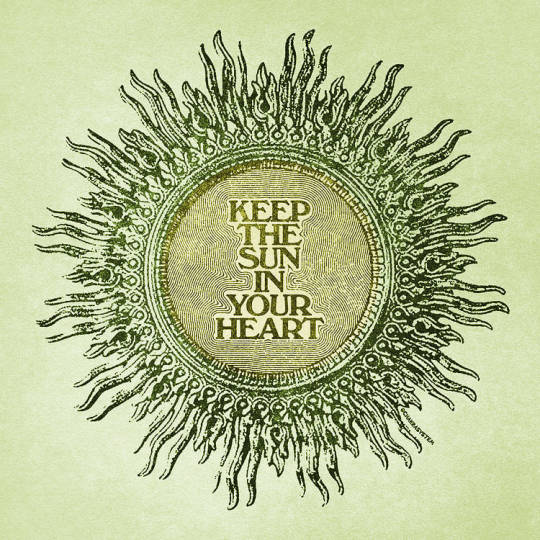
Many sun gods and goddesses are humanoid and ride or drive a vessel of some sort across the sky. It may be a boat, a chariot, or a cup. The sun god of the Greeks and Romans, for example, rode in a four-horse (Pyrios, Aeos, Aethon, and Phlegon) chariot.In Hindu traditions, the sun god Surya travels across the sky in a chariot pulled by either seven horses or a single seven-headed horse. The chariot driver is Aruna, the personification of dawn. In Hindu mythology, they fight the demons of darkness.There may be more than one god of the sun. The Egyptians differentiated among the aspects of the sun and had several gods associated with it: Khepri for the rising sun, Atum for the setting sun, and Re for the noontime sun, who rode across the sky in a solar bark. The Greeks and Romans also had more than one sun god.
Solar Liaisons by Talon Abraxas
65 notes
·
View notes
Text
Chapter 8: Sepulcrum
“What I did not expect, however, is that so much would be retained that it could, all of it, be casually questioned. Not just to know that Phlegon of Tralles had found in truth the teeth of dinosaurs, where all things stone put books to shame, but claims—bold claims—that Cicero himself might be too biased to be trusted. There isn’t the same safety that I once expected, in the vast expanse of time. And fixing books, adjusting books, annotating and editing, begins to feel like so much wasted time.” He knits his fingers together over his chest. “That said, it is my eternal hope that Plutarch was correct when he described the fate of Sulla. That I never argued.”
(plutarch time)
#my fic#tvc#armand#marius de romanus#hell yeah. penetrable as fuck#read penetrable text you got there
10 notes
·
View notes
Note
Fine,
Pyrois ("The Fiery One"),
Aeos ("He of the Dawn"),
Aethon ("Blazing"),
and Phlegon ("Burning")
:)
…
Those are actually amazing.
2 notes
·
View notes
Text
Love finding ancient ghost stories. This one comes from ~350 BCE.
A newly-wed girl named Philinnion died and was buried in a family tomb. Six months after her death, a guest, Machates, came to stay at her parents' house. Philinnion fell in love with him, and every night she came to sleep with him in secret until one night her parents walked in:
When her parents first saw her, they were speechless and panic-stricken, but after that they embraced their daughter. Then Philinnion said to them: 'Mother and father, how unfairly you have grudged my being with the guest for three days in my father's house, since I have caused no one any pain. For this reason, on account of your meddling, you shall grieve all over again, and I shall return to the place appointed for me. For it was not without divine will that I came here.' Immediately upon speaking these words she was dead, and her body lay stretched out visibly on the bed. Her father and mother threw themselves upon her.
The event was quickly heard through the city and was reported to me. Accordingly, during the night I kept in check the crowds that gathered at the house, since, with news like this going from mouth to mouth, I wanted to make sure there would be no trouble.
By early dawn the theatre was full. After the particulars had been explained, it was decided that we should first go to the tomb, open it, and see whether the body lay on its bier or whether we would find the place empty. A half-year had not yet passed since the death of the girl. When we opened the chamber into which all deceased members of the family were placed, we saw bodies lying on biers, or bones in the case of those who had died long ago, but on the bier onto which Pilinnion had been placed we found only the iron ring that belonged to the guest and the gilded wine cup, objects that she had obtained from Machates on the first day.
Astonished and frightened, we proceeded immediately to Demostratos's house to see if the corpse was truly to be seen in the guest room. After we saw the dead girl lying there on the ground, we gathered at the place of assembly, since the events were serious and incredible.
-Phlegon of Tralles' Book of Marvels Trans. William Hansen
10 notes
·
View notes
Text

Some quickie Helios Headcanons, to elaborate upon at a later date:
Helios takes the care and training of his horses very personally. There are six horses in total, four in rotation hitched to the the chariot on any given day while two remain in his stables to recuperate. They are: Aithôn, Pyrois, Eous, Phlegon, Abraxas and Bronte. All of the horses are manifestations of Helios’s power, but are also independent creatures in their own right. They are telepathically and empathically bonded with the Titan. To lay a hand on any of them unbidden is, in short, a death sentence.
Helios’s stables also houses other deified horses, such as Pegasus, Therbeeo, and Xanthos. At times, he will make use of these horses instead of his core six steeds.
Empowered with the ability of All-Sight, Helios can both see and hear everything that men and gods do during the time that he is in the sky. But he is not All-Knowing, and this can mean that he doesn’t always have context for that which he witnesses. Especially if related actions have taken place at night, while he is asleep in his villa.
Despite being accustomed to watching literally everyone, Helios is unfamiliar with (and therefore uncomfortable with) the experience of being watched himself. XD
When it comes to the mortal realm, the wintry season swaddles Helios into a state of perpetual lethargy, only shaken off at the height of day (and sometimes, not even then). It’s fortuitous that the sunlit hours are intended to be so short, because the Titan is not certain he would have the energy for a longer path across the sky. Besides, it affords Eos extra minutes to linger in a pre-dawn light, if she so desires.
In various historical writing, Helios’s home has been described as a “Golden Palace” of great splendor. But those writings hearken back to the time of the Titanides, when Helios’s own Father was free of Tartarus and in power. Much of that power was diminished with the coming of the Deities of Olympus. These days, Helios’s home is more like a countryside villa than anything resembling a palace. The interior remains gilded in bright colors and reflective surfaces, but with a more modest and… intimate atmosphere.
In addition to his villa at the edge of the world, Helios also maintains a second residence in Rhodes, in accordance with the temple dedicated to him there.
#Fandom: Lore#c: Helios | The Chariot#Helios: headcanon#Horses of the Sun#hc that i have accumulated recently through writing and chatting with others#hc
3 notes
·
View notes
Photo

Phoebe Introduced...
1-2 I want this letter to introduce to you Phoebe, our sister, a deaconess of the Church at Cenchrea. Please give her a Christian welcome, and any assistance with her work that she may need. She has herself been of great assistance to many, not excluding myself.
3-5 Shake hands for me with Priscilla and Aquila. They have not only worked with me for Christ, but they have faced death for my sake, Not only I, but all the Gentile churches, owe them a great debt. Give my love to the little church that meets in their house.
6-7 Shake the hand of dear Epaenetus, Achaia’s first man to be won for Christ, and of course greet Mary who has worked so hard for you. A handshake too for Andronicus and Junias my kinsmen and fellow-prisoners; they are outstanding men among the messengers and were Christians before I was.
8-9 Another warm greeting for Amplias, dear Christian that he is, and also for Urbanus, who has worked with me, and dear old Stachys, too.
10-12 More greeting from me, please, to Apelles, the man who has proved his faith, the household of Aristobulus, Herodion, my kinsman, Narcissus’ household, who are Christians. Remember me to Tryphena and Tryphosa, who work so hard for the Lord, and to my dear Persis who has also done great work for him.
13-15 Shake the hand of Rufus for me—that splendid Christian and greet his mother, who has been a mother to me too. Greetings to Asyncritus, Phlegon, Hermes, Patrobas, Hermas and their Christian group: also to Philologus and Julia, Nereus and his sister, and Olympas and the Christians who are with them.
16 Give each other a hearty handshake all round for my sake. The greetings of all the churches I am in touch with come to you with this letter.
A final warning
17-18 And now I implore you, my brother, to keep a watchful eye on those who cause trouble and make difficulties among you, in plain opposition to the teaching you have been given, and steer clear of them. Such men do not really serve our Lord Jesus Christ at all but are utterly self-centred. Yet with their plausible and attractive arguments they deceive those who are too simple-hearted to see through them.
19-20 Your loyalty to the principles of the Gospel is known everywhere, and that gives me great joy. I want to see you experts in good, and not even beginners in evil. It will not be long before the God of peace will crush Satan under your feet. May the grace of our Lord Jesus Christ be with you.
21-24 Timothy, who works with me, sends his greetings, and so do Lucius and Jason and Sosipater my fellow-countrymen. (Paul has just told me that I, Tertius, who have been taking down this epistle from his dictation, may send you my Christian greetings too.) Gaius, my host (and the host as a matter of fact of the whole church here), sends you his greetings. Erastus, our town clerk, and Quartus, another Christian brother, send greetings too.
25-27 Now to him who is able to set you on your feet as his own sons—according to my Gospel, according to the preaching of Jesus Christ himself, and in accordance with the disclosing of that secret purpose which, after long ages of silence, has now been made known (in full agreement with the writings of the prophets long ago), by the command of the everlasting God to all the Gentiles, that they might turn to him in the obedience of faith—to him, I say, the only God who is wise, be glory for ever through Jesus Christ!
— Romans 16 | J.B. Phillips New Testament (PHILLIPS)
The New Testament in Modern English by J.B Phillips copyright © 1960, 1972 J. B. Phillips. Administered by The Archbishops’ Council of the Church of England.
Cross References: Genesis 3:15; 2 Samuel 15:6; Matthew 5:47; Matthew 7:15; Mark 15:21; Acts 2:9; Acts 9:13; Acts 9:31; Acts 13:1; Acts 18:2; Acts 18:18; Acts 19:22; Acts 20:28; Romans 1:2; Romans 1:8; Romans 2:16; Romans 8:11; Romans 9:3; Romans 11:36; 1 Corinthians 16:20; 2 Corinthians 5:17; 2 Corinthians 12:2; Galatians 1:22; 1 Thessalonians 5:12; Philemon 1:19; 2 John 1:1
#greetings#love#introduction#Phoebe#avoid divisions#praise to God#The Epistle of Romans#Romans 16#New Testament#PHILLIPS#J.B. Phillips New Testament Bible#The Archbishops’ Council of the Church of England
4 notes
·
View notes